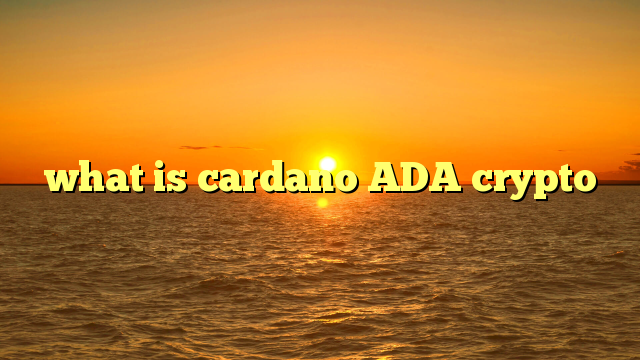Cardano ADA:The cryptocurrency landscape continues to evolve at a breakneck pace, with new projects vying for dominance. Among these contenders, Cardano (ADA) has emerged as a strong player, capturing the imagination of investors and developers alike. But what exactly is Cardano ADA, and how does it differentiate itself in a crowded market? This comprehensive guide delves into the intricate workings of the Cardano ecosystem, from its foundational principles to its practical applications.
What is Cardano? A Blockchain Platform Reimagined
Cardano, named after the 16th-century mathematician Gerolamo Cardano, is a public, decentralized blockchain platform. Unlike traditional financial systems controlled by central authorities, Cardano empowers individuals to participate in a secure and transparent network. This network facilitates peer-to-peer transactions using its native cryptocurrency, ADA, named after Ada Lovelace, a pioneer in computer programming.
Core Principles: A Foundation Built on Research and Innovation
One of Cardano’s defining characteristics is its unwavering commitment to peer-reviewed research. Unlike many blockchains that rely on trial-and-error approaches, Cardano’s development adheres to rigorous academic standards. This focus on evidence-based methods fosters a secure and scalable platform, crucial for widespread adoption.
Proof-of-Stake: A Sustainable Alternative
Cardano ADA utilizes a Proof-of-Stake (PoS) consensus mechanism, a significant departure from the energy-intensive Proof-of-Work (PoW) system employed by Bitcoin. In PoS, users stake their ADA tokens to validate transactions, securing the network and earning rewards in return. This mechanism translates to a more sustainable and environmentally friendly blockchain.
Scalability: Gearing Up for the Future
Scalability is a critical challenge for many blockchains, often leading to slow transaction processing times and high fees. Cardano’s addresses this concern through a layered architecture. This design separates transaction settlement from smart contract execution, enabling the network to handle a significantly higher volume of transactions efficiently.
Smart Contracts: Powering Decentralized Applications
Similar to Ethereum, Cardano ADA allows developers to build decentralized applications (dApps) using smart contracts – self-executing programs that operate on the blockchain. These dApps have the potential to revolutionize various industries, from finance and supply chain management to voting systems and identity management.
The Top 10 Advantages of Cardano ADA
Security: Backed by a rigorous development process and a robust PoS system, Cardano ADA offers a high degree of security for transactions and applications.
Scalability: The layered architecture paves the way for efficient and scalable transaction processing, critical for mass adoption.
Sustainability: The PoS consensus mechanism significantly reduces energy consumption compared to PoW-based blockchains.
Interoperability: Cardano ADA is designed to be interoperable with other blockchains, fostering a more connected and collaborative ecosystem.
Peer-Reviewed Research: The commitment to academic research ensures a strong foundation for the platform’s development.
Strong Community: A dedicated community of developers and users fuels Cardano’s growth and innovation.
Active Development: The development team is constantly working on improvements and introducing new features to the platform.
Regulation-Friendly: Cardano’s focus on compliance and regulatory frameworks makes it an attractive option for businesses.
Multiple Use Cases: The platform’s versatility allows for a wide range of applications across various industries.
Governance: Cardano ADA holders will eventually have voting rights on future upgrades and changes to the network, fostering a more decentralized governance structure.
Investing in Cardano ADA : A How-to Guide
For those interested in acquiring ADA tokens, several options are available. Here’s a basic roadmap:
Choose a Cryptocurrency Exchange: Select a reputable cryptocurrency exchange that supports ADA trading. Popular options include Coinbase, Binance, and Kraken.
Fund your Account: Deposit funds into your exchange account using a bank transfer, debit card, or other supported methods.
Place an Order: Navigate to the cardano ADA trading pair (e.g., ADA/USD) and place a buy order for your desired amount.
Secure Storage: Store your ADA tokens securely in a cryptocurrency wallet. Hardware wallets offer the highest level of security, while software wallets provide more convenience.
Recent Developments in the Cardano’s Ecosystem (as of May 8, 2024):
Cardano’s ecosystem is constantly developing. Here’s a glimpse into some recent noteworthy events:
Shenandoah Upgrade: Successfully implemented in March 2024, the Shenandoah upgrade introduced several enhancements, including improved smart contract capabilities and faster transaction processing times.
DJET Stablecoin Launch: The highly anticipated DJET stablecoin, pegged to the US dollar, launched on the Cardano’s network in April
Cardano in the Spotlight: Statistics, Challenges, and Future Outlook
Cardano by the Numbers: A Statistical Snapshot
Understanding Cardano’s impact requires examining some key statistics. Here’s a data-driven perspective:
Market Capitalization (as of May 8, 2024): Over $35 billion, placing Cardano among the top 10 cryptocurrencies globally [CoinMarketCap data can be referenced here].
Transaction Volume (Daily Average): Over 1 million transactions processed daily, showcasing the network’s growing activity [Data on Cardano’s transaction volume can potentially be found on Cardano’s blockchain explorers like Adapools or Pooltool].
Number of Active Wallets: Millions of active wallets holding ADA tokens, indicating a sizable user base. [Active wallet data might be available on Cardano’s block explorers or network insights platforms]
Development Activity: Cardano’s consistently ranks among the most actively developed blockchain projects, with a dedicated team continuously improving the platform. [Metrics on development activity can be found on platforms like Santiment or CoinGecko]
Challenges and Considerations
Despite its strengths, Cardano ADA is not without its challenges. Here are some key considerations:
Competition: The cryptocurrency market is fiercely competitive, with established players like Ethereum and emerging rivals vying for market share.
Regulation: The regulatory landscape surrounding cryptocurrencies remains uncertain, which could impact Cardano’s adoption.
Smart Contract Maturity: While Cardano supports smart contracts, the platform is still relatively young compared to Ethereum, and its smart contract ecosystem is evolving.
Network Effect: Achieving widespread adoption is crucial for Cardano’s success. Building a robust network effect will be essential for attracting developers and users.
The Road Ahead: Cardano’s Future Trajectory
Looking forward, Cardano’s roadmap is ambitious. Here are some anticipated developments:
Goguen Era: The ongoing Goguen era focuses on integrating smart contract functionality and enabling the creation of dApps on the Cardano blockchain.
Basho Era: The upcoming Basho era aims to further enhance scalability and transaction processing speed.
Voltaire Era: The Voltaire era will introduce on-chain governance, allowing Cardano ADA holders to participate in voting on future upgrades and platform changes.
Shelley Era: The already implemented Shelley era established decentralization through stake delegation and pool rewards.
Conclusion: Demystifying Cardano’s Potential
Cardano presents a compelling proposition within the blockchain landscape. Its focus on research, sustainability, and scalability positions it as a strong contender for the future. While challenges remain, the ongoing development efforts and a dedicated community suggest that Cardano has the potential to revolutionize various industries and empower individuals through a secure and decentralized network.





